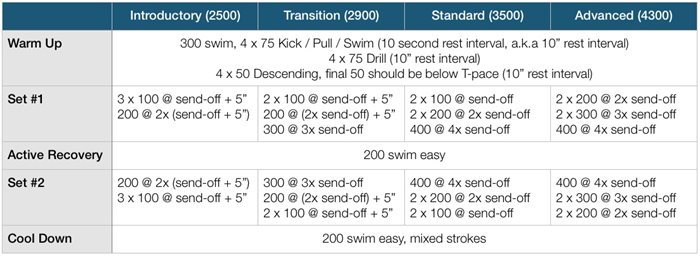Chances are, if you’ve read a book about training, followed a training plan, had your lactate threshold tested, or just been paying attention, you’ve heard about training zones. Training zones play a critical role in creating specificity in your training. However, you almost never hear reference to training zones with regards to swim workouts. You might vary your swim pace between fast, moderate, and easy, and you’re probably resting for 10 to 20 seconds after each interval regardless of pace, but that hardly counts as specificity. Wouldn’t it be better if you could build the same specificity into swim workouts that you rely on for bike and run workouts?
How To Translate Training Zones For Swim Workouts
Any given bike or run workout is some combination of intervals that each have a specified intensity, duration, and recovery interval. By examining bike and run workouts designed for different training zones, you can mimic these same combinations of intensity, duration, and recovery for swim workouts. In doing so, you can create the same training specificity for swim that you know and love for bike and run.
For example, let’s look at a Sweet Spot workout. The Sweet Spot (SST) is a training zone used in cycling workouts because it provides substantial fitness benefits without requiring substantial recovery time between workouts. For that same reason, the SST swim workout is both applicable and valuable throughout your training season.
An SST workout on the bike might include three to six blocks of work at your SST power or heart rate- a high level tempo pace just below threshold. These tempo blocks can range from 5 to 20 minutes, and you might get two to five minutes of active recovery between them.
Now that you understand the structure of an SST bike workout, you can translate that to an SST swim workout.
For an SST swim, you simply build mixed sets of 100 to 400 yard or meter intervals and swim those sets a few seconds slower than your threshold pace per hundred yards or meters. However, in order to mimic a five to 20 minute tempo block you only take roughly five seconds rest per hundred between intervals.
Defining Your Sweet Spot Pace and Send-Off Interval
Before you swim your first SST workout, you’ll need to do a benchmark 1000 yard/meter time trial to fine tune your pacing and intervals. That is a long continuous swim, and you may be tempted to use repetitions of a shorter distance instead. However, swimming 3 x 300 or 8 x 100 won’t accomplish the same thing. You can swim 3 x 300 faster than you can swim a straight 1000. So get your head around it, go swim 1000 for time, and then divide that time by ten to find your threshold pace (T-pace). Your SST pace is simply your T-pace plus one to three seconds per hundred.
From there, you need to calculate your send-off interval. A send-off interval is the total amount of time between individual intervals in a set. The send-off interval includes both the time needed for the swim and also the time you get to rest. If you swim faster, you get more rest, and vice versa. Why use a send-off interval and not simply a rest interval? Because if you’re just focused on the rest interval, there is no accountability for the pace at which you are swimming. Consistent pacing and rest is best accomplished by swimming on a send-off interval.
To calculate your send-off interval, add five to ten seconds to your T-pace, finding an interval that ends in a 0 or a 5. For example, a 1:32 T-Pace will swim on a 1:40 send-off; a 1:49 T-pace will swim on a 1:55 send-off. If your T-pace ends in a 5 or a 0, use your current fitness level to gauge whether to add five or ten seconds to find your send-off interval. This send-off interval then scales along with the interval distance. If your send-off is 1:45 for 100, it’s 3:30 for 200, 5:15 for 300, etc.
Easing Into Sweet Spot Workouts
Your first SST swim workout is going to be a test set of 10 x 100, swimming at your SST pace on your send-off interval. If you can hold your send-off interval for the entire set, you’re ready to go. If you miss your send-off interval at any point within the test set, you’re going to ease into it a bit.
Below are two sample Sweet Spot swim workouts. Each workout has an Introductory level (if you missed your send-off interval three to six 100s into the test set), a Transition level (if you missed your send-off seven to nine 100s in), a Standard level, and an Advanced level (if you barely broke a sweat during the test set). At all levels, your goal is to swim the sets at your SST pace. Once you’re getting more than fifteen seconds rest per hundred at the Introductory or Transition levels, move up a level. If you’re getting more than ten seconds rest per hundred at the Standard level, it’s time to repeat the 1000 yard/meter time trial and re-calculate your SST pace and send-off interval.
Sample Sweet Spot Workout #1

Sample Sweet Spot Workout #2

Beyond the sample SST swim workouts above, the possibilities are infinite. You can use any random combination of intervals to build the sets, as long as you follow the general structure of the workout. You can repeat the same set for each tempo block, or you can make each block a little different. Do what works best for you, but also be sure to include the sets that you would normally shy away from. Sometimes it’s good to do the ones that scare you.



